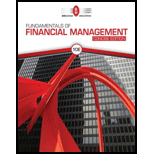
Concept explainers
a.
To calculate:
Future value of cash flow: If a single cash flow is currently invested with a
b.
To calculate: Future value of cash at 12% compounded semiannually for 5years.
Future value of cash flow: If a single cash flow is currently invested with a compound interest, then its growth over the period of time is known as future value of cash flow.
c.
To compute: Future value of cash at 12% compounded quarterly for 5 years.
Future value of cash flow: If a single cash flow is currently invested with a compound interest, then its growth over the period of time is known as future value of cash flow.
d.
To compute: Future value of cash at 12% compounded monthly for 5 years.
Future value of cash flow: If a single cash flow is currently invested with a compound interest, then its growth over the period of time is known as future value of cash flow.
e.
To compute: Future value of cash at 12% compounded daily for 5 years.
Future value of cash flow: If a single cash flow is currently invested with a compound interest, then its growth over the period of time is known as future value of cash flow.
f.
To explain: Reason for the occurrences of this observed pattern in face value.
Future value of cash flow: If a single cash flow is currently invested with a compound interest, then its growth over the period of time is known as future value of cash flow.
Trending nowThis is a popular solution!

Chapter 5 Solutions
Fundamentals Of Financial Management, Concise Edition (mindtap Course List)
 EBK CONTEMPORARY FINANCIAL MANAGEMENTFinanceISBN:9781337514835Author:MOYERPublisher:CENGAGE LEARNING - CONSIGNMENT
EBK CONTEMPORARY FINANCIAL MANAGEMENTFinanceISBN:9781337514835Author:MOYERPublisher:CENGAGE LEARNING - CONSIGNMENT Cornerstones of Financial AccountingAccountingISBN:9781337690881Author:Jay Rich, Jeff JonesPublisher:Cengage Learning
Cornerstones of Financial AccountingAccountingISBN:9781337690881Author:Jay Rich, Jeff JonesPublisher:Cengage Learning




